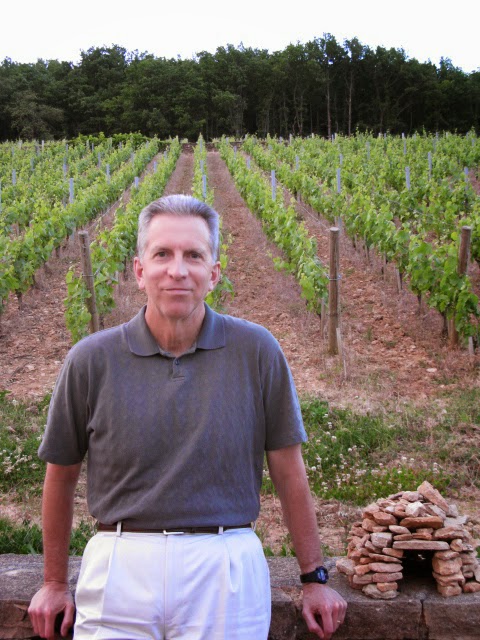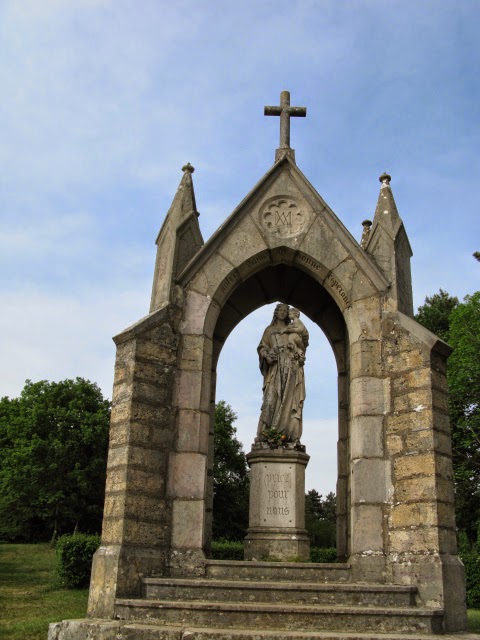Hello to all our friends
of wine and cuisine. Bonjour, les amis de vin et la cuisine. Welcome
again to Cépage et
Cuisine, Mary’s and Brian’s wine and food blog. We’re winding things up in Burgundy. Today is our last full day here before we begin
our transition to Bordeaux.
As we
planned our trip, we talked about a visit to the Abbaye Notre-Dame des Cîteaux,
a Cistercian abbey in Saint-Nicholas-lès-Cîteaux, about 15 minutes east of
Nuits-Saint-Georges. The Cistercian
monks at the abbey produce a wonderful mild cheese that is widely available in
Burgundy. The cheese is called simply
Abbaye de Citeaux. It is a washed rind
cheese made with unpasteurized milk from cows that graze on the grounds of the abbey.
Because the cheese is a raw milk cheese
that is sold soon after it is made, it is illegal to import into the U.S. We love the cheese and it pairs beautifully
with Burgundy wine, another example of “what grows together goes together.” The photo above is not one we took. It is clipped from the Internet, explained
below.
After the
morning sojourn to the boulangerie to pick up a croissant and baguette for
Mary, we goofed off around the gite and moseyed over to Saint-Nicholas-lès-Cîteaux
around 12:30. We packed a picnic of
cherries, charcuterie, cheese, the baguette for Mary, and a half-bottle of wine
we had left over from the previous evening.
We stopped at a park and enjoyed the peace and quiet of the countryside,
then arrived at the abbey at 1:30.
The
monks are at lunch or in prayer until 2:30, so we walked around the
grounds. A sign admonishes visitors to
be silent. So we were as quiet as, ahem,
church mice. Promptly at 2:30, the
chapel bell rang and we went to the entrance to learn that the 2:30 tour was
full and we needed a reservation. Alas, we
couldn’t stay that quiet for another hour, so we went back toward the Côte.
We didn't get to see the monks or the cheese operation, which is why we didn't get to take our own photos. The abbey was beautiful and I hope we can visit there in the future with better planning.
I’m
always fascinated by the Hill of Corton and all the grand cru vineyards on its
slopes. Like many vineyards in Burgundy,
there is a cross in the middle of Corton-Charlemagne. There are small service roads the vineyard
workers use to get up there. I didn’t
want to drive up there during working hours, but I managed to find the right
road late in the evening a couple of days ago.
Here’s the cross, one of the iconic images of Corton-Charlemagne.
Adjacent
to the cross, a clever vineyard worker or visitor fashioned a miniature
vineyard hut on a rock wall.
I was
hoping to visit Domaine Jean Chartron, a producer of fine white Burgundy in
Puligny-Montrachet, but was unable to send an email requesting an appointment. We just drove to the domaine, hoping they
would be open to walk-ins.
We were
greeted by a very nice lady whose name we can’t recall. She is British and has lived in Puligny for 25
years, so we had a nice, relaxed conversation in English.
She tasted us through a few wines that we
enjoyed very much. She had no wines to
pour from before 2012 because of the severe effect of hailstorms on the yield
in Burgundy during 2011 and 2012.
Dinner
that evening was at Auberge Saint Martin in Bouilland, a small country village
not far from Savigny-les-Beaune. It’s
one of those villages that is reached by a winding, narrow country lane that
makes you think you’re lost. Then, there
it is. It is nestled in a narrow valley
between two ridges. The main street is
about the only flat part of town.
The
restaurant is run by the chef, Didier Poulet and his delightful wife, who
manages the dining room. It was a bit
chilly to dine on the deck overlooking the town.
Like
always, we were the first to arrive. By
the end of the evening, there were more people.
The amuse
was a cool and creamy spread of a yogurt with chives and dill.
We both
started with a sensational entrée course
of what you see here on this little specials board.
It’s a cream-based soup of white asparagus
and a little cake of pureed vegetables, carrot, zucchini, and celery. How he dreamed up this dish is beyond us but
it was delicious.
My plat was a ballotine de poulet, chicken stuffed with mushrooms, maybe pine
nuts, and carrots, along with spring vegetables and crêpes de
pommes de terre, potato pancakes.
Mary’s
was filet de truite meunière, crème
d'aligoté, trout meuniere in a white wine cream sauce with vegetables.
Both dishes were wonderful. I declared mine to be the best I have experienced
so far on the trip. Aside from the
quality, flavor, and complexity of the dish, the creativity, inventiveness, and
presentation were great. I mean, how did
he decide to pair potato pancakes with a fancy presentation of chicken? And how much care and time goes into
arranging the wild asparagus over the carrot strips and zucchini in just that
way?
Dessert was presented in
the same manner. Mary had a mousse of
strawberries, topped by cherries, sliced strawberries, and gooseberry.
I asked if they could
prepare a fresh fruit dessert and Didier presented this lovely plate of sliced
strawberries and other fruit with a branch of delicate acacia blossoms.
Of course, we had coffee
and Madame Poulet brought these little coffee cookies.
We planned the meal
around a white Burgundy because we’ve had a lot of hearty, red meat
dishes. The choice was this Domaine
Rapet Pernand-Vergelesses Les Combottes 2012.
It was refreshing with vibrant lemon, apples, clean mineral notes, a
creamy, smooth texture, excellent balance and good length. It was delicious with the food choices.
Auberge Saint Martin is a place to come again, and so we will.
After dinner, we took a
few photos of Bouilland at about 9:15 in the evening. What a pretty little town.
That’s our post for today. Tomorrow, we move to Saint-Saturnin in the
Auvergne, about halfway to our Bordeaux destination. We plan to just mosey along the backroads,
stopping to take photos and experience the French countryside off the beaten
path. We’ll post again as soon as we
can. Please check back for more entries
at Cépage et Cuisine. In the meantime,
Cheers!
Mary♥Brian














































































